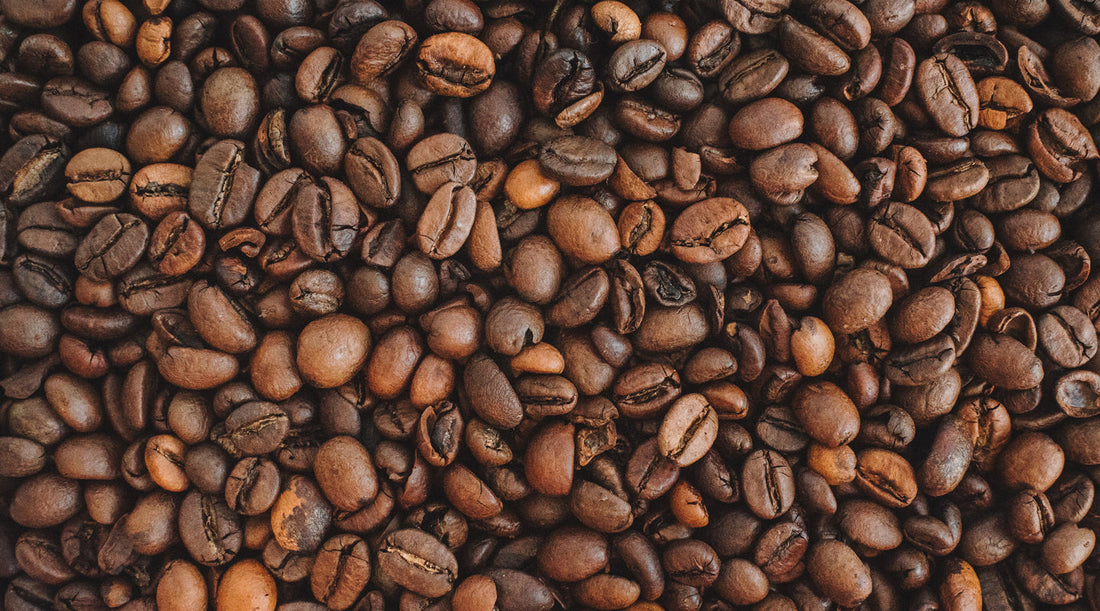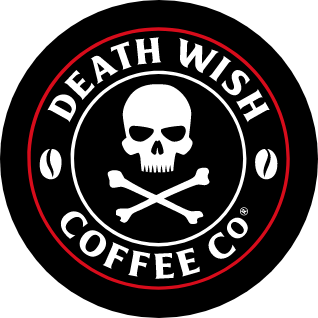
Dark Roast vs. Medium Roast: What’s The Difference?
Coffee TalkThe Difference Between Roast Shades
Whenever someone asks what type of coffee you like, the only correct answer is, "The one with the caffeine." But we know that different types of coffee—light, medium and dark roasts—attract different types of people. What you might not realize is that sticking to one roast coffee might mean you're missing out on a world of flavors you never knew existed.
See, the roasting process takes the same coffee beans and, depending on how long you roast them, makes them taste completely different in the mug. Here's how that magic happens, plus how the taste and strength vary in light roast vs. medium roast vs. dark roast. We'll also share something about caffeine content that will likely blow your mind.
The Secret Art of Roasting and Crack(ing)

[Photo Credit: Battlecreek Coffee Roasters via Unsplash]
You might know nothing about roasting, but you can sound like a pro (and understand the difference between light and dark roast) if you can just remember the Three-Crack Rule. This won't make any sense now, but it will in a moment.
The roasting process helps coffee beans become what we think of as “coffee beans.” It's when you take raw or green coffee beans and expose them to heat. This process removes moisture from the bean and also changes the color, aroma and flavor of the green coffee beans into something you'd actually want to make a drink with.
Roasters are craftsmen (or women). It takes skill—and trial and error—to determine exactly when to remove coffee beans in order to achieve the desired result in a cup of coffee.
As coffee beans slowly heat up, the flavors and acidity begin to change, and the color begins to brown as the sugars and amino acids in the beans react together. Eventually, typically somewhere around 350 F, the beans go through the first crack. As the name implies, the beans expand to the point where you can hear them crack. You could remove the beans now and have light roast coffee beans. Or you can keep heating them and allow the body and heavier flavors of your future coffee to build. When the temperature climbs to about 440-450 F, the beans crack again. This second crack releases oils to the surface of the beans.
You don't want to roast coffee beans much beyond the second crack. Unless you want a mugful of charcoal-tasting liquid.
The First Crack: Light Color and High Acid
If you remove coffee beans right after the first crack, you have light roast beans. It doesn't take a genius to figure out that these beans have a light brown color. When brewed, lighter roasts are, well, light. They have little or no oil and a thin body. Some might consider them watery. The flavor is delicate yet complex. It's often described as some mix of fruity, citrus, sweetness and floral hints. If you have a sensitive stomach, grab some TUMS: Light roast coffee is high in acidity.
If you're interested in trying light roast coffee, look for names like cinnamon roast, light city and half city.
The Second Crack: Medium Color and Balanced Flavor
Medium roast beans are removed from heat right before the second crack. The additional exposure to heat causes the beans to develop a toasty flavor and a brown color. Medium roast coffee has a little more heft than lighter roasts but usually minimal or no oil. It's less acidic than a light roast, but it maintains some acidity. Most people describe medium roast as “balanced.” It has a balanced flavor, aroma and acidity. But don't let that fool you. When roasted correctly, medium roast's flavor isn't flat; instead, it's complex. In one sip of Medium Roast Death Wish Coffee, you might notice notes of stone fruit. In the next, hints of caramel and roasted peanuts come through. And the finish? Delicious, smooth, give-me-more dark chocolate.
If you're interested in trying medium roast coffee, look for names like city roast, American roast, regular roast and breakfast roast.
The 2+ Crack: Darker Color and Increased Body
Medium-dark roast coffee beans are removed right at or after the second crack. The coffee beans are a darker brown color and have some oil on the surface. They have less acidity but more body than lighter roasts. A cup of coffee made with medium-dark roast beans is spicy with notes of caramel and chocolate. You might notice some smokiness and a bittersweet tang.
If you're interested in trying medium-dark roast coffee, look for names like full-city roast, after-dinner roast and Vienna roast.
The Third Crack: Darkest Color and Bold, Bold, Bold
Finally, the good stuff! Dark roast coffee beans are roasted until after the second crack. This takes finesse because if you roast too much longer, your coffee will taste like arse. As you can likely guess by now, the beans have a dark brown (or almost black) color. And since they've gone through both the first and second crack, they're also oily. Dark roast has the heaviest body and lowest acidity of coffee roasts. Dark roast coffee is rich and bold—you'll taste smokiness, some bitterness, toast and chocolate. Dark Roast Death Wish Coffee is smooth, never bitter, with subtle notes of cherry and dark chocolate.
If you're interested in trying dark roast coffee, look for names like espresso roast, Italian roast, French roast, continental roast and Spanish roast.
Medium Roast vs. Dark Roast: Which Provides the Most Buzz?
Great. But what about the most important thing—the caffeine? We didn't talk about it above because roast has nothing to do with caffeine. Don't let the baristas at the chain coffee shop tell you otherwise; they know nothing about good coffee. The truth is, if you take the same variety of green coffee beans (like arabica or robusta), no matter how long you roast it—to light, medium or dark roast—you'll get about the same amount of caffeine.
The roasting process changes the color, flavors, aromas, acidity and body of the coffee beans and their resulting joe. But the roasting process has little effect on the caffeine content in those coffee beans and your mug. Caffeine only begins to degrade at very high temperatures. And those temperatures are beyond the level where you roast coffee beans, even the darkest roasts.
But the thing is, it's also really, really hard to make a medium or dark roast with an extra kick of caffeine taste so good. We were able to do this because our roaster is a ninja who knows exactly when to pull coffee beans out of the roaster and how to blend just the right amounts of just the right beans.
We use only the highest quality USDA Certified Organic, Fair Trade coffee beans you can find. We are always testing the beans to be sure they taste amazing and are the highest octane. Beans are the real secret to caffeine bliss. Robusta coffee beans are loaded with caffeine. We're talking about twice as much jolt as arabica coffee beans contain. Unfortunately, all of that caffeine makes robusta beans taste really bitter. Worse than eating a lemon. So we balance out robusta beans with arabica (in our dark roast) and both arabica and Yirgacheffe beans (in our medium roast) to create coffee that not only keeps you energized for all you need to do but also makes you want to keep drinking it all day.
A Bold, Smooth Brew
For the average coffee, most people equate "strong" with "high caffeine." That's fine...if you only care about caffeine and don't care about flavor. But Death Wish Coffee isn't your average coffee. We take everything into account when making our strong coffees: how bold the flavor in your mug is, what type of beans are in your brew and, duh, the kick it delivers to get you going.
That's why we made our Medium Roast as potent as our Dark Roast, but with a completely different flavor profile. Here's how our two roast levels compare:
Death Wish Medium Roast Coffee
The beans: Robusta, arabica and Yirgacheffe beans grown at a higher altitude in Ethiopia, India and Peru. That elevation lends a complex yet balanced flavor profile to the cup.
The color: A shade or two lighter than our original blend.
The caffeine: Defiantly strong with an extra kick of caffeine.
The acidity: Low acid. Low bitterness.
The profile: Still bold but more mellow and super smooth.
How the coffee tastes: Nuanced with notes of stone fruit, hints of caramel and roasted peanuts and a finish of smooth dark chocolate.
Death Wish Dark Roast Coffee
The beans: Robusta and arabica beans sourced from nutrient-rich soil in India and Peru.
The color: Super dark brown, almost black.
The caffeine: Fiercely strong with an extra kick of caffeine, similar to our Medium Roast.
The acidity: Equally as low as our medium roast.
The profile: Strong coffee flavor. No bitterness. But slap-in-the-face intense.
How the coffee tastes: More standardized with a richer flavor of cherry and dark chocolate throughout.
The best way to know if you prefer dark roast or medium roast coffee is to try it! Pick up a bag of Medium Roast or Dark Roast Death Wish Coffee. Or get one of each and do your own taste test.
[Featured Image Credit: Anastasiia Chepinska via Unsplash]
Related: Arabica vs. Robusta Coffee
